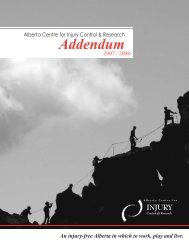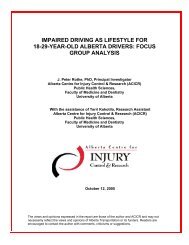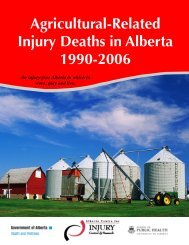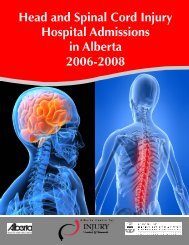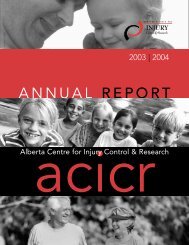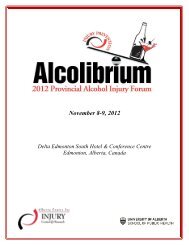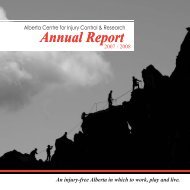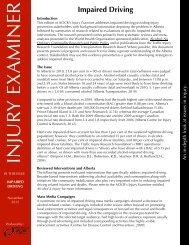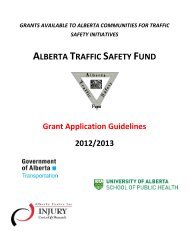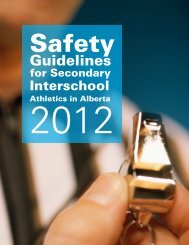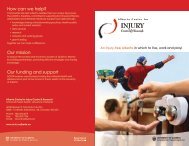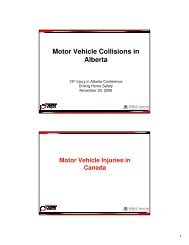JUNE 2003 - Alberta Centre for Injury Control & Research
JUNE 2003 - Alberta Centre for Injury Control & Research
JUNE 2003 - Alberta Centre for Injury Control & Research
Create successful ePaper yourself
Turn your PDF publications into a flip-book with our unique Google optimized e-Paper software.
OTHER INJURY DATA FOR ALBERTA<br />
Other injury data have also been analyzed by the ACICR. These data are<br />
presented next to build the knowledge base on injuries in <strong>Alberta</strong>.<br />
Role of alcohol in injury<br />
In<strong>for</strong>mation collected and maintained by <strong>Alberta</strong>’s Office of the Chief<br />
Medical Examiner was analyzed by ACICR. The Office of the Chief<br />
Medical Examiner is responsible <strong>for</strong> examining all persons who died from<br />
sudden and unknown causes.<br />
Alcohol was determined to be a major factor in injury deaths 21 :<br />
• In 2001, in 15% of all fall related deaths, the deceased was legally impaired<br />
at the time of their injury.<br />
• In 2001, 63.6% of all hypothermia deaths had alcohol levels exceeding the<br />
legal limit to drive in <strong>Alberta</strong>.<br />
• Within the past five years, 59.5% of the boating fatalities in <strong>Alberta</strong><br />
involved the use of alcohol.<br />
• In 2001 in <strong>Alberta</strong>, 5% of drivers involved in injury crashes had consumed<br />
alcohol prior to the collision. That number increased to 21% of drivers<br />
involved in fatal collisions. In terms of licensed drivers, males aged 18-21<br />
were more likely to be drinking be<strong>for</strong>e the crash.<br />
• Between 1991 and 2000, 12.6% of motorized snow vehicle operators<br />
involved in casualty collisions had consumed alcohol prior to the collision.<br />
This figure increased to 75% <strong>for</strong> fatal collisions.<br />
Clearly alcohol plays a major role in injuries, with excessive drinking<br />
increasing the probability that an injury will occur and very often result in<br />
death.<br />
<strong>Injury</strong> and First Nations People<br />
The leading cause of death among First Nations people in <strong>Alberta</strong> is<br />
injuries. <strong>Injury</strong> related deaths in <strong>Alberta</strong> are greater than the number of<br />
deaths associated with heart disease, tumors and respiratory diseases<br />
combined. Data on injuries involving First Nations people were supplied by<br />
22 23<br />
the First Nations and Inuit Health Branch. The following injury data<br />
provides a portrait of the injury concerns in First Nations communities.<br />
• In <strong>Alberta</strong> between 1983 and 1999, injuries and poisonings represented the<br />
number one cause of death among the First Nations population accounting<br />
<strong>for</strong> 1,975 deaths or 39% of all deaths <strong>for</strong> all causes among First Nations<br />
people.<br />
• <strong>Injury</strong> and poisoning deaths are two times higher than the number of deaths<br />
associated with diseases of the circulatory system; and almost four times<br />
higher than deaths associated with cancer.<br />
Making <strong>Alberta</strong> the Safest Place to Live<br />
77



